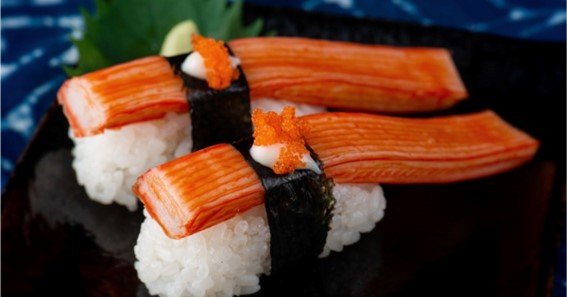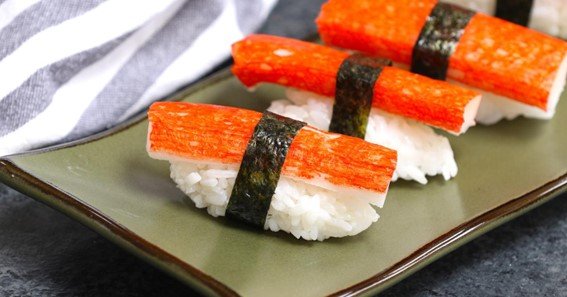Kani sushi is a Japanese roll that employs kanikama, surimi, or crab sticks instead of genuine crab meat. The name “crab” might be misleading because it refers to both actual crab meat and surimi, a cheaper imitation.
To appreciate kani sushi, one needs to study the crabs utilized, their lifespans, cooking methods, and cultural significance. This inquiry helps you adore sushi more and highlights seafood’s moral and environmental issues.
What Is Kani?
Kani is a type of Japanese sushi roll where fake crab meat, also called kanikama, surimi, or crab sticks, is used in place of real crab meat. Crab is a popular Japanese ingredient due to its mild taste and versatility. Seafood sushi can include crab meat in nigiri, maki, or more complex sushi rolls.
Outside of Japan, kani sushi is popular and available at sushi restaurants worldwide. Different crabs affect kani sushi’s flavor, texture, and lifespan. Many people employ Alaskan king crabs, snow crabs, blue crabs, and other crabs.
Many people appreciate Alaskan king crab for its huge, delicious legs and snow crab for its delicate, somewhat sweet taste. Surimi, white fish like pollock or cod blended with starch, sugar, and other ingredients to taste and feel like crab flesh, is the major ingredient in fake crab.
Exploring The Versatility And Significance Of Kani Sushi

Kani sushi—a phrase that conjures up crab sushi—includes several dishes that demonstrate crab meat’s versatility and flavor. From classic nigiri to novel rolls, kani sushi exhibits culinary talent and cultural significance.
Real crab, ecological concerns, and surimi’s success make us appreciate this beloved seafood delight. Discussing kani sushi’s health advantages, cultural importance in Japanese food, and unique sushi restaurants’ takes make it more intriguing.
Various Crabs Used
Choosing the appropriate crab influences sushi flavor, texture, and longevity. Alaskan king crab and snow crab have distinct tastes and textures. Alaskan king crab legs and sushi rolls are popular due to their size and flavor. Snow crab, with its sweet, delicate flesh, is another popular choice. Blue crab is largely American. For sushi, it’s lovely and versatile.
Concerns Concerning Sustainability
Sustainable crab purchase is crucial due to overfishing and environmental degradation. Sustainable crab fishing includes Alaskan king and snow crabs. This prevents native stock loss from harvesting. Sustainable crab purchases promote marine ecosystem preservation and responsible fisheries.
Imitation Crab Surimi
Imitation crab (surimi), marketed as kani and used in sushi rolls, is cheaper than genuine crab. Adding diced pollock or cod to starch, sugar, and flavorings makes surimi taste like crab flesh. Fake crab is inexpensive and simple to get, so sushi recipes employ it even if it doesn’t taste as good.
Health Thoughts
Real crab flesh tastes excellent and is healthy, so people enjoy it. Its foods are rich in protein, minerals, vitamins (including B12), and omega-3s. These nutrients are healthy and beneficial. Although less nutritious than genuine crab, imitation crab may be part of a balanced diet in moderation.
Well-known Kani Sushi Dishes
Many famous dishes use kani sushi, and each one has its own cooking style and taste profile. For a standard version of kani sushi, make California rolls with avocado, cucumber, and crab (real or fake) wrapped in nori (seaweed) and sushi rice.
Spider rolls have soft-shell crab tempura inside, which gives them a crispy texture that goes well with the veggies and sushi rice. Dynamite rolls usually have crab, avocado, and hot mayo on them, which gives normal sushi items a tasty kick.
Meaning In Terms Of Culture
Japanese society and food both have meanings connected to crab. In addition to sushi, crab is also enjoyed in other ways, like in kani miso soup, where the insides of the crab are used to make a rich, flavorful sauce.
Grilled crab is another famous meal that shows off how simple and sweet crab meat is by itself. Japan’s love of crab comes from its coastal history and its long-standing relationship with fish as a main source of food.
Changes In Restaurants
Different sushi places make kani sushi in their special ways, using local products and new ideas in cooking. Chefs can try new things with seasonal or local fish to make unique sushi rolls that show off creativity and freshness.

Conclusion
In the above, we discuss what is kani sushi and know more about it. Kani sushi is a great example of how culinary art, national tradition, and caring for the earth can all come together in sushi. Knowing where kani sushi came from and what it means makes the dinner experience better, whether you’re eating traditional dishes like California rolls or trying out new sushi creations.
FAQ
Where does fake crab come from?
Imitation crab, or surimi, is usually made from white fish (like pollock or cod) that has been chopped, starch, sugar, and flavorings and fillers to give it different textures and tastes.
Does real crab always go into Kani sushi?
No, you don’t have to use real crab meat to make kani sushi. You can use surimi instead, which is cheaper.
How do I know if the crab in Kani sushi is safe to eat?
Please inquire with your host or the sushi cook about the crab type and where it came from. For peace of mind, look for approvals like MSC (Marine Stewardship Council).
What are some well-known Kani sushi rolls?
California rolls (avocado, cucumber, crab), spider rolls (soft-shell crab), and dynamite rolls (crab, avocado, hot mayo) are some of the most popular kani sushi rolls.
Why is it important to make kani sushi with crab that doesn’t hurt the environment?
Buying sustainable crab helps protect marine ecosystems and makes sure that crab populations can grow back for future generations to enjoy. This practice helps fish responsibly and protects the earth.
Sources:
https://sustainablesushi.net/kani-crab/
https://www.alldayieat.com/blog/what-is-kani-in-sushi
We have covered all the below topics in the above article
Kani meaning
Kani sushi
Kani crab
Kani food










